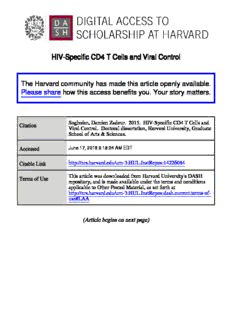
HIV-Specific CD4 T Cells and Viral Control The Harvard community has made this article openly ... PDF
Preview HIV-Specific CD4 T Cells and Viral Control The Harvard community has made this article openly ...
HIV-Specific CD4 T Cells and Viral Control Citation Soghoian, Damien Zadour. 2015. HIV-Specific CD4 T Cells and Viral Control. Doctoral dissertation, Harvard University, Graduate School of Arts & Sciences. Permanent link http://nrs.harvard.edu/urn-3:HUL.InstRepos:14226084 Terms of Use This article was downloaded from Harvard University’s DASH repository, and is made available under the terms and conditions applicable to Other Posted Material, as set forth at http:// nrs.harvard.edu/urn-3:HUL.InstRepos:dash.current.terms-of-use#LAA Share Your Story The Harvard community has made this article openly available. Please share how this access benefits you. Submit a story . Accessibility HIV-specific CD4 T cells and Viral Control A dissertation presented by Damien Zadour Soghoian to The Division of Medical Sciences in partial fulfillment of the requirements for the degree of Doctor of Philosophy in the subject of Virology Harvard University Cambridge, Massachusetts October 2014 © 2014 Damien Zadour Soghoian All rights reserved. Dissertation Advisor: Dr. Bruce D. Walker Damien Zadour Soghoian HIV-specific CD4 T cells and Viral Control Abstract CD4 T cells play an important and central role in the immune system, coordinating the arms of the adaptive immune system to shape an effective response while simultaneously regulating non- essential or deleterious activities. Their critical necessity is demonstrated most strikingly during acquired immunodeficiency syndrome (AIDS), when depletion of CD4 T cells by human immunodeficiency virus (HIV) type 1 ultimately results in a host of immune dysfunctions and susceptibility to opportunistic pathogens. Although virus-specific CD4 T cell responses are generally vital for the control of viral infections, HIV-specific CD4 T cells have long been recognized to be preferentially targeted and depleted by the virus—raising questions about their utility as immune effectors both during HIV-1 infection and in the context of a prospective HIV- 1 vaccine. However, more recent research has challenged the notion that HIV-specific CD4 T cells are only relevant as targets. There is a growing appreciation for the crucial role that these cells may play in mediating anti-HIV immunity through a diverse array of effector functions— including direct anti-viral cytotoxicity. Here we show that HIV-specific CD4 T cell responses are evident throughout the course of HIV disease, including acute infection. In particular, an expansion of HIV-specific CD4 T cells with cytolytic potential early after acute HIV infection is associated with lower viral set point and better clinical progression. This expansion is evident iii both as an increase in HIV-specific CD4 T cells able to degranulate upon antigen recognition and as cells with a unique granzyme and perforin expression pattern. Further, HIV-specific cytolytic CD4 T cell responses are functionally enhanced in the setting of durable HIV control during chronic infection, where they exhibit a profile reminiscent of HIV-specific CD8 T cells and are associated with T-bet and Eomesodermin expression. We also show that in HIV controllers, the function of HIV-specific CD4 T cells is very tightly correlated with clinical status. Together these results strongly support the concept that CD4 T cells are critical players in the cellular immune response to HIV, and point to specific CD4 T cell functions—including direct cytolysis—which may be most important for anti-HIV immunity. iv TABLE OF CONTENTS Chapter Page Chapter 1: Introduction 1 Chapter 2: HIV-specific cytolytic CD4 T cell responses during acute HIV infection 44 predict disease outcome Chapter 3: HIV-specific cytolytic CD4 T cell function is enriched in HIV controllers 83 and associated with coordinated transcription factor expression Chapter 4: Identification of virus-specific CD4 T cell signatures associated with 120 spontaneous HIV-1 control by automated dimensionality reduction Chapter 5: Conclusions 151 v Dedication: This thesis is dedicated first and foremost to my parents, Stephanie and Richard Soghoian, for their unwavering support over the past three decades. It is also dedicated to the countless friends and family who have encouraged me in my scientific career. vi Chapter 1: Introduction Sections of this chapter are modified from the peer-reviewed publication: Soghoian, DZ and Streeck, H. Cytolytic CD4(+) T cells in viral immunity. Expert Rev Vaccines. 2010 Dec;9(12):1453-63. 2 THE GLOBAL HIV/AIDS EPIDEMIC AND THE NEED FOR AN HIV VACCINE HIV/AIDS represents the most devastating infectious disease epidemic in modern history. Since the first reports of HIV-associated syndromes in the early 1980s, the disease has claimed nearly 35 million lives. There are currently nearly the same number of people infected worldwide, and 1.6 million people die of the disease each year [1]. Due in part to socioeconomic factors, the HIV/AIDS epidemic disproportionately affects Sub-Sarahan Africa, particularly South Africa, which is home to the largest number of people living with HIV/AIDS of any country [1]. HIV was first identified as the causative agent of AIDS in 1983, and efforts to identify antiretroviral compounds began shortly afterwards [2]. Zidovudine (AZT) became the first drug approved to treat HIV, in 1987. Since then, an army of drugs have been developed, which block HIV replication by targeting different points of the viral lifecycle [2]. These medications are remarkably effective when used as a multi-drug cocktail and have transformed HIV from a deadly illness to a manageable chronic condition in which life expectancy can approach that of an HIV-uninfected individual [3]. However, anti-HIV medications are expensive and require strict adherence in order to maintain efficacy [4, 5]. Economic factors in particular have hindered the deployment of antiretrovirals in the places that require them most, such as Sub- Sarahan Africa. Indeed, only 59 percent of those in this region living with HIV have access to antiretroviral therapy, even as treatment guidelines have shifted to recommend earlier treatment [6]. Moreover, a large proportion of those being treated are not virally suppressed, which encourages the development of resistance to common therapies and additional viral spread [6, 7]. Various prevention strategies have also been initiated or are in development, such as topical 3
Description: